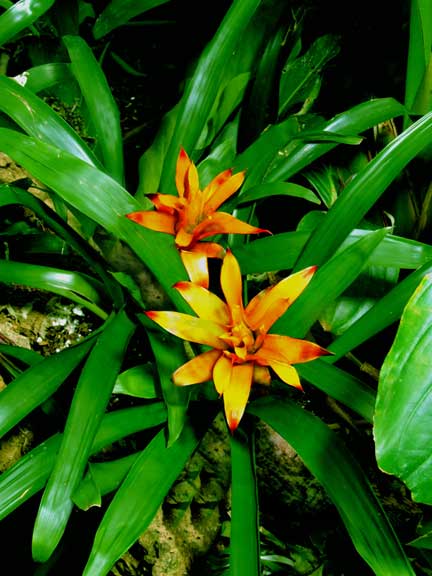![]()
Plants in the Collection
Take the Tour Now?
Orchids
The
Exotic Rainforest
Plants in
the Exotic Rainforest Collection
Images on this website are copyright protected. Contact us before
attempting to reuse.

Guzmania Hybrids
Being normally epiphytes (tree dwellers) Guzmania species also provide homes and food to many rainforest animals. A large variety of animals and insects find their way to these plants growing way up on the branches of jungle trees. One reason they come is water. The bromeliad collects rainwater for its own use but will share its resource with a large number of jungle inhabitants including birds and small animals. Some animals, like the colorfully beautiful red, blue or yellow poison dart frogs (which can be less than ½ inch long) actually lay their eggs inside the cone of the bromeliad! "Dart" frogs were once used by jungle natives to coat the tips of their "poison darts" by rubbing the end of the dart with the mucous found on the frog's skin. Most of the insects and creatures that visit the bromeliad do absolutely no harm and many assist the bromeliad by leaving nutrients that the plant can feed upon. Some visit the bromeliad due to the attraction of the pollen in the inflorescence. Those that depend on the bromeliad for part of their existence are in a select group called the bromeliad's "biota". According to Dr. J. Howard Frank there are several hundred species of animals and plants that are known to depend on the bromeliad in some way. Some use it as a place to hide or live, some as a source of food or water, others as a place to rear their young. The word biota means "all living organisms, regardless of whether they are animals, plants, fungi, bacteria, or viruses" that utilize or depend on the bromeliad in some way. Guzmania hybrids are now extremely popular houseplants which come in a large variety of colors and sizes. Easy to grow, all they require is a good source of bright indirect light and a cone filled with clean water and they'll delight you with their "flowers" which are known scientifically as an inflorescence. Most have an inflorescence that can live for up to 3 months. Once the inflorescence is spent don't throw the bromeliad away! If given time it will produce new plants around its base which can be separated and grown until they "flower" for you as well.